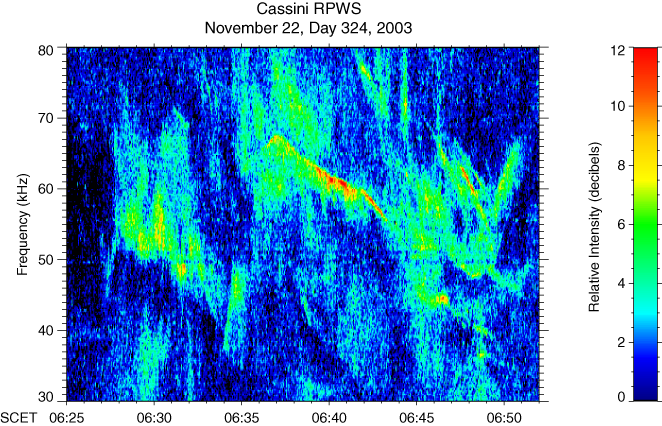|
Sounds from Space |
|
|
..
June 30, 2007 Speech patterns have been found in a radio signal released by NASA almost 3 years previously in 2004. Judge for yourself what the voices are saying, it is a very bizarre anomaly but very much worth investigating. Instructions: 1) Download and save the original
WAV file from NASA/Cassini website: 2)Open an audio editor like Cool Edit or Sonar and raise the pitch/frequency of the file by 12 tones with the pitch shifter.. and there it is, speech patterns. How can anyone explain this anomaly.
Certainly NASA have no explanation for it after we
presented the file to them for their opinion. SETI
also does't know what make of it. What do you think?
|
|
|
Bizarre Features of Saturn's Radio Emissions ..
Listen
to
the Sounds (Java) Saturn is a source of intense radio emissions. The radio waves are closely related to the auroras near the poles of the planet. These auroras are similar to Earth's northern and southern lights. The Cassini spacecraft began detecting these radio emissions in April 2002 when Cassini was 2.5 astronomical units from the planet using the Cassini Radio and Plasma Wave Science (RPWS) instrument. The RPWS has now provided the first high resolution observations of these emissions that show an amazing array of variations in frequency and time. In this example, it appears as though the three rising tones are launched from the more slowly varying narrowband emission near the bottom of this display. If this is the case, it represents a very complicated interaction between waves in Saturn's radio source region, but one which has also been observed at Earth! The sound of the radio emissions can be heard by clicking on the button labeled "Audio" or in an animated version (which shows a cursor that indicates time on the spectrogram) by clicking on "A Java animation." Time on this recording has been compressed such that 13 seconds corresponds to 27 seconds, or, about 2x real time. Since the frequencies of these emissions are well above the audio frequency range, we have shifted them downward by a factor of 260. Bill Kurth From" "Sounds of Space" collected by
U Iowa instruments on various spacecraft.
|
|
|
The Eerie Sounds of Saturn's Radio Emissions ..
Listen
to
the Sounds (Java) Saturn is a source of intense radio emissions. The radio waves are closely related to the auroras near the poles of the planet. These auroras are similar to Earth's northern and southern lights. The Cassini spacecraft began detecting these radio emissions in April 2002 when Cassini was 2.5 astronomical units from the planet using the Cassini Radio and Plasma Wave Science (RPWS) instrument. The RPWS has now provided the first high resolution observations of these emissions that show an amazing array of variations in frequency and time. The complex radio spectrum with rising and falling tones is very similar to Earth's auroral radio emissions. These structures indicate that there are numerous small radio sources moving along magnetic field lines threading the auroral region. The sound of the radio emissions can be heard by clicking on the button labeled "Audio" or in an animated version (which shows a cursor that indicates time on the spectrogram) by clicking on "Animate." Time on this recording has been compressed such that 73 seconds corresponds to 27 minutes, or, the recording is at 22x real time. Since the frequencies of these emissions are well above the audio frequency range, we have shifted them downward by a factor of 44. Bill Kurth From" |
|
|
..
June 05, 2007 posted by from: hryzunik From an original
CD: JUPITER NASA-VOYAGER SPACE SOUNDS (1990)
BRAIN/MIND Research
Fascinating recording of Jupiter sounds (electromagnetic "voices") by NASA-Voyager. The complex interactions of charged electromagnetic particles from the solar wind , planetary magnetosphere etc. create vibration "soundscapes". It sounds very interesting, even scary. Jupiter is mostly composed of hydrogen and helium. The entire planet is made of gas, with no solid surface under the atmosphere. The pressures and temperatures deep in Jupiter are so high that gases form a gradual transition into liquids which are gradually compressed into a metallic "plasma" in which the molecules have been stripped of their outer electrons. The winds of Jupiter are a thousand metres per second relative to the rotating interior. Jupiter's magnetic field is four thousand times stronger than Earth's, and is tipped by 11° degrees of axis spin. This causes the magnetic field to wobble, which has a profound effect on trapped electronically charged particles. This plasma of charged particles is accelerated beyond the magnetosphere of Jupiter to speeds of tens of thousands of kilometres per second. It is these magnetic particle vibrations which generate some of the sound you hear on this recording.
Visit http://www.inner-net.com/bmr/bmrpg2aa.html for more sounds. |
|
|
Space Sounds Navigator ..
Space Sounds Home Page |
|
|
Sounds of Space ..
"Sounds of Space" collected by U Iowa instruments on various spacecraft |
|
| FAIR USE NOTICE: This page contains copyrighted material the use of which has not been specifically authorized by the copyright owner. Pegasus Research Consortium distributes this material without profit to those who have expressed a prior interest in receiving the included information for research and educational purposes. We believe this constitutes a fair use of any such copyrighted material as provided for in 17 U.S.C § 107. If you wish to use copyrighted material from this site for purposes of your own that go beyond fair use, you must obtain permission from the copyright owner. | |
|
|




